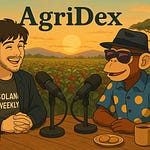In-Depth Show Notes
Podcast: Solana Weekly with Thomas
Episode Guest: Gus Marquez from Parcl
Duration: 1:01:18
Introduction (00:01 - 00:30)
Host: Thomas introduces the episode of Solana Weekly, welcoming Gus Marquez from Parcl, a platform integrating real estate exposure on the Solana blockchain.
Guest: Gus expresses excitement about discussing Parcl’s mission to bring real estate returns on-chain without directly tokenizing physical properties.
What Parcl Does (00:30 - 03:34)
Concept Clarification: Gus explains that Parcl isn’t about tokenizing real estate but rather providing exposure to real estate returns via on-chain indexes. These indexes represent aggregated real estate data (e.g., median price per square foot) from cities, with potential future expansions to niche markets like ski or beach towns.
Data Backbone: Parcl Labs, the data arm, indexes every home in the U.S., capturing live listing and sales data to create accurate, ground-level price representations.
Accessibility: Users can access data for major metro areas via an API, with custom requests possible for less-covered regions like Wichita, Kansas.
Parcl Labs and Data Use Cases (03:34 - 04:39)
Secondary Revenue Stream: Parcl Labs’ data feeds serve public sector clients, private investment funds, and partners like Truflation (for inflation prediction), showcasing its utility beyond Parcl’s core platform.
Future Plans: A dashboard for non-technical users and institutional-quality reports are in development, aiming to bridge data insights into investment strategies on Parcl.
Genesis and Evolution of Parcl (04:39 - 07:55)
Origin Story: Co-founders Trevor and Kellen, former investment managers, conceived Parcl during COVID, observing migration trends (e.g., New York to Miami) and seeking a way to gain financial exposure without physical property management.
Shorting Challenge: Inspired by the lack of tools to short real estate (unlike Michael Burry’s 2008 credit bet), they explored blockchain solutions with co-founder Jason, a data expert from Microsoft.
Development Phases:
V1: A simple MakerDAO-style CDP contract experiment.
V2: Launched with an NFT (HOA) in partnership with the Sioux Foundation, raising funds for a home down payment giveaway; limited by risk management issues.
V3: Current iteration, refined with feedback from a hedge fund user, offering dynamic risk management akin to Synthetix, live for 1.5 years.
Real Estate Market Dynamics and Parcl’s Role (07:55 - 14:22)
Observations: Thomas notes California’s price surge despite outmigration, contrasting with Parcl’s ability to long/short cities.
Data Scale: Gus details Parcl’s extensive data sources—county records, MLS listings, mortgage bond portfolios—enabling granular insights like buyer credit profiles.
Market Efficiency: Gus argues real estate lacks two-way flow (long/short) seen in stocks, leading to mispricings (e.g., San Francisco’s rent vs. own disparity). Parcl aims to create a balanced, efficient market.
Use Cases: Examples include saving for a home while tracking market returns or hedging property value for retirement.
Financialization and Pain Points (14:22 - 23:08)
Housing as an Asset: Thomas highlights real estate’s heavy financialization (mortgages, PMI) yet limited sophistication compared to other markets, where Parcl fills a gap.
Investor Challenges: Gus shares personal motivation from his parents’ financial crisis losses, critiquing the “all-in” homeownership narrative against diversification principles.
Physical Ownership Costs: Thomas, a property manager, and Gus discuss hidden costs (e.g., squatters, maintenance, vacancies), exemplified by a co-worker’s year-long squatter issue and Thomas’s tenant non-payment during COVID.
V3 Reframe: Parcl targets aspiring and experienced investors, offering returns without management hassles, with a rebranded front-end comparing physical vs. Parcl investment outcomes.
Market Trends and Liquidity (23:08 - 29:35)
Current Trends: Gus notes increased supply and low demand in markets like Florida, Atlanta, and Phoenix, driven by institutional exits and high interest rates, with uncertain demand recovery despite rate drops.
Liquidity Advantage: Parcl offers low closing costs (18 basis points vs. 2-5% for physical real estate) and up to 50x leverage, contrasting with traditional limits (max 10x).
NFT Analogy: Thomas compares housing to NFTs—community-driven pricing with slower liquidity—highlighting Parcl’s edge in flexibility.
Data Aggregation and Blockchain Integration (30:09 - 35:08)
Data Challenges: Gus explains the initial difficulty of aggregating data from county records and MLS, now streamlined into an efficient process.
On-Chain Process: Parcl uses a forked Pyth V1 oracle to publish daily price updates on Solana, with heavy data processing done off-chain.
Latency Discussion: Thomas and Gus explore Solana’s speed (450ms block time) vs. traditional markets (microseconds), noting Parcl’s daily updates mitigate latency concerns, unlike high-frequency trading platforms.
Solana Ecosystem and Competition (35:08 - 42:16)
Solana Choice: Parcl opted for Solana pre-launch due to low transaction costs compared to expensive EVM and nascent L2s, with no plans to replicate elsewhere given improving bridging solutions.
Ecosystem Evolution: Thomas highlights Solana’s user-driven innovation (NFTs, meme coins) and competition from platforms like Hyperliquid, Zeta, and Drift, pushing for lower latency and better UX.
Real Estate Community Response (42:16 - 46:29)
Initial Friction: Gus notes early difficulties explaining Parcl’s synthetic derivative model to real estate professionals, who found it “too good to be true.”
Shift in Approach: Feedback from a commercial real estate user sparked a rebrand to use familiar terms (e.g., cash-on-cash return), aligning with traditional investors’ language and needs.
Simplification Goal: Parcl aims for a front-end so intuitive that investors instantly recognize it as a real estate platform, abstracting blockchain complexity.
Alternatives and Community Building (46:29 - 52:48)
Lack of Alternatives: Gus contrasts Parcl with REITs (property management-focused, no shorting) and fractional ownership (illiquid), affirming Parcl’s unique position.
Community Bootstrap: Parcl used the HOA NFT and airdrops to early traders/liquidity providers, successfully building a community, though some churn occurred post-incentive season. Lessons include aligning incentives with organic behavior.
Product Market Fit and Future (52:48 - 1:01:18)
Current Use: Users trade short-term (median hold: 3.5 days), but Parcl seeks longer holding periods (6-9 months) for true product-market fit, tuning its perpetual futures contract accordingly.
Long-Term Vision: Thomas sees Parcl as a gateway for retail to invest in real estate as a stable asset on Solana, fostering retention beyond meme coin volatility.
Updates: V3 protocol is live; a new front-end launches in 4-5 weeks, running alongside the old UI. Parcl Labs reports will integrate with the platform, enhancing investment decisions.
Closing (1:01:18)
Thomas: Expresses enthusiasm for Parcl’s progress and plans to explore it further.
Gus: Thanks Thomas, noting Parcl Labs reports will soon be available at parcllabs.com.













Share this post